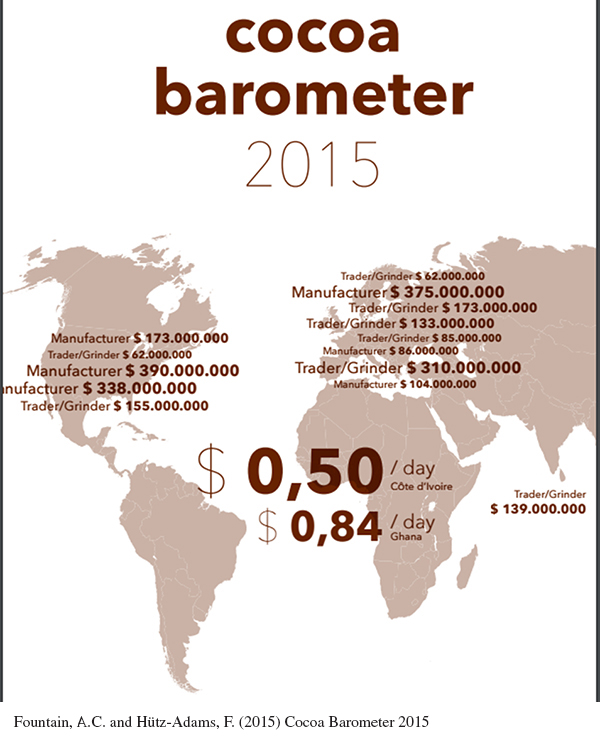Chapter 10.
10.1 Chapter 10: Genre Talk
Click to enlarge the images and view the Web article and professional report, which examine the problem of child labor in the chocolate industry. Check your understanding of genre by answering the following questions. Then “submit” your work.



Heading: cocoa barometer 2015 In the background, is a world map, with data listed over the map. The following data appears over the North America section of the map: Manufacturer $173.000.000 Trader/Grinder $62.000.000 Manufacturer $390.000.000 Manufacturer $338.000.000 Trader/Grinder $155.000.000 The following data appears over the Europe section of the map: Trader/Grinder $62.000.000 Manufacturer $375.000.000 Trader/Grinder $173.000.000 Trader/Grinder $133.000.000 Trader/Grinder $85.000.000 Manufacturer $86.000.000 Trader/Grinder $310.000.000 Manufacturer $104.000.000 The following data appears below India on the map: Trader/Grinder $139.000.000 In larger numbers over Africa is the following data: $0,50/day Côte d'Ivoire; $0,84/day Ghana.
The text on this page reads as follows: Heading: Role of governments Text: The debate about the role of governments in sustainable cocoa is intensifying. Governments of producing countries should play a pivotal role to improve the situation of farmers. They should be transparent in taxes received on cocoa, and invest a significant part of this income in rural technical and social infrastructure (including roads, electricity, education, water and sanitation, and health care) or other indispensable public goods cocoa farmers rely on. They should regulate the activities of companies in their country and facilitate development aid and civil society actors. The UN Guiding Principles on Business and Human Rights (UNGP) clearly sets forth that is the state's duty to protect against human rights abuses. As such, it the role of producing governments to ensure the social, environmental, and economic wellbeing of farmers, their families, and the cocoa growing communities. With their anti-trust policies, governments in consuming countries should be firm on power concentration in processing facilities under their jurisdiction. Additionally, they should support producing governments or facilitating organisations with expertise. Four marginal notes appear to the right of this section of text and read as follows: Recommendation: Ensure transparency in government revenue received on cocoa. Recommendation: Invest adequately in rural infrastructure and services. Recommendation: Be transparent about payments to governments and national cocoa institutions. Recommendation: Ensure that market concentration does not reach market distorting levels. The text then continues: Heading: Developments in producing countries Text: As a result of the first World Cocoa Conference and the Global Cocoa Agenda, most producer governments are setting up National Cocoa Development Plans (NCDP). The approaches of these NCDP's differ, depending on the situation in the country. Ecuador has announced it wants to pass legislation guaranteeing sustainable cocoa production, with a state-run agency controlling enforcement, and subsequently to discard the programmes run by the different foreign stakeholders. Côte d'Ivoire, Ghana and Indonesia are also planning new regulations. The two biggest producing countries are regulating their national cocoa markets through the National Marketing Boards, the Cocobod in Ghana and the Conseil du Café-Cacao (CCC) in Côte d'Ivoire .
This is a screenshot of the blog post from the Huffpost Taste webpage. The menu listing the different sections of the Huffington Post website run across the top below the Huffpost Taste heading. The blog post appears below. Title: Is There Child Labor In Your Chocolate? Text: Whether you celebrate Valentine's Day or not, biting into a velvety piece of chocolate is likely a non-negotiable activity on your February 14 agenda. In fact, Americans will eat more than 58 million pounds of chocolate in the weeks leading up to one of the sweetest days of the year. No surprise there, right? We love our chocolate! But what you may not love, or even be aware of, is the reality of what it takes to get our delicious cocoa to market. As is the case with most agricultural commodities, in the cocoa industry it's the people on the front lines of the supply chain—the farmers—who get the least return. Cocoa farmers in West Africa, where 70% of the world's cocoa comes from, can earn as little as $0.25–$0.50 a day, and are stuck in deep cycles of poverty. The systematically low prices in cocoa have drastic consequences for farmers and their families. More than 2 million children in the Ivory Coast and Ghana are being deprived of their childhoods, either working in extremely hazardous conditions or workng in lieu of going to school, so that we can get our chocolate fix. And even as demand for cocoa increases, as it has over the last five years, dependence on child labor has shown little signs of improving. In fact, according to a study conducted by Tulane University, the number of children involved in hazardous work in cocoa increased 46% in the Ivory Coast between 2009 and 2014. Below the article text is a photo of cocoa beans in a pod. The photo credit reads: Fair Trade USA. Photo: DEA/G. SIOEN/Getty Images.